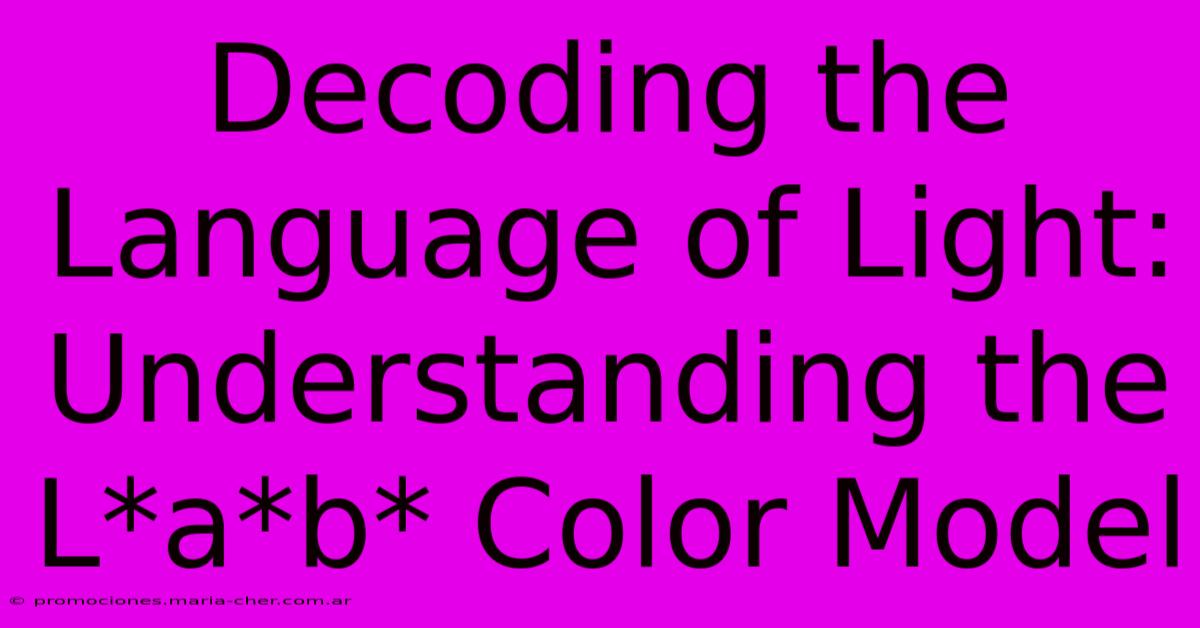Decoding The Language Of Light: Understanding The L*a*b* Color Model

Table of Contents
Decoding the Language of Light: Understanding the Lab* Color Model
Have you ever struggled to accurately describe a color? RGB values can be confusing, and even HEX codes don't always paint the full picture. That's where the Lab* color model comes in – a powerful tool for understanding and specifying colors with unmatched precision. This comprehensive guide dives deep into the Lab* color space, explaining its advantages, applications, and how it differs from other color models.
What is the Lab* Color Model?
The Lab* color model, also known as CIELAB, is a device-independent color space. This means it's designed to represent colors consistently, regardless of the device used to display or print them. Unlike RGB, which is based on the mixture of red, green, and blue light, and CMYK which uses cyan, magenta, yellow, and key (black) inks, Lab* uses a more perceptually uniform system. This makes it ideal for tasks requiring accurate color reproduction and comparison.
Understanding the Components:
-
L (Lightness):* This component ranges from 0 (black) to 100 (white), representing the perceived lightness or darkness of a color. Think of it as the overall brightness of the color.
-
a (Red-Green):* This axis represents the red-green opponent process. Positive values indicate redness, while negative values indicate greenness. Zero signifies a neutral position.
-
b (Blue-Yellow):* This axis represents the blue-yellow opponent process. Positive values indicate yellowness, while negative values indicate blueness. Zero signifies a neutral position.
Why Use Lab*?
The Lab* color model boasts several key advantages over other color spaces:
-
Device Independence: Its device-independent nature ensures consistent color representation across different displays and printing technologies.
-
Perceptual Uniformity: Small changes in Lab* values correspond to small changes in perceived color differences. This makes it perfect for color difference calculations and color management.
-
Wide Gamut: Lab* encompasses a much broader range of colors than RGB or CMYK, enabling the representation of colors outside the typical display capabilities.
-
Precise Color Specification: Its numerical values offer a highly precise method for describing colors, essential for professionals in graphic design, printing, and photography.
Applications of the Lab* Color Model:
The Lab* color model finds applications in various fields:
-
Graphic Design: Ensuring accurate color reproduction in printed materials and digital designs.
-
Photography: Color correction and editing, ensuring consistent color across different devices and platforms.
-
Printing: Accurate color matching between digital designs and printed outputs.
-
Textiles and Fashion: Defining and matching colors in fabric production and design.
-
Food Science: Assessing and standardizing the color of food products.
-
Colorimetry and Color Science Research: Fundamental for color measurement and analysis.
Lab* vs. Other Color Models: A Comparison
| Feature | Lab* | RGB | CMYK |
|---|---|---|---|
| Type | Device-independent | Device-dependent | Device-dependent |
| Perceptual Uniformity | High | Low | Low |
| Gamut | Wide | Limited | Limited |
| Applications | Color management, precision | Screen displays | Printing |
Mastering the Lab* Color Model: A Path Forward
Understanding the Lab* color model is crucial for anyone working with color professionally. Its precision, device independence, and perceptual uniformity make it an invaluable tool for accurate color representation and management. While the initial learning curve might seem steep, the benefits far outweigh the effort. By grasping the fundamentals of L*, a*, and b*, you'll unlock a new level of control and accuracy in your color workflow. Embrace the language of light and harness the power of Lab*!

Thank you for visiting our website wich cover about Decoding The Language Of Light: Understanding The L*a*b* Color Model. We hope the information provided has been useful to you. Feel free to contact us if you have any questions or need further assistance. See you next time and dont miss to bookmark.
Featured Posts
-
Witness The Majesty Of The Mighty Lakes Dossin Great Lakes Museum Webcam
Feb 10, 2025
-
Unveiling The Rainbow Connection Your Color Intelligence Revealed
Feb 10, 2025
-
The Nail Polish That Makes Your Hands Sing Experience The Joy Of Dnd Daisy Gel Polish
Feb 10, 2025
-
Dnd Gel Wineberry The Ethereal Nail Lacquer Of Dreams
Feb 10, 2025
-
Color Speak How Dnc Nail Polish Translates Your Political Views
Feb 10, 2025
